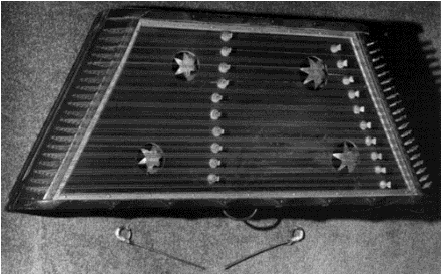|
There has been some confusion over who the ‘Will’ Lawrence who played
and made dulcimers was, as there were several Williams in the Lawrence
family. The Lawrence family have lived in this area of Cambridgeshire for
over three hundred years, with the forename William passed down in the
family since 1717. However, the ‘Will’ referred to now seems fairly certain
to have been
George Willmott Lawrence’s younger brother, born in 1869.
The numerous family comments do not make it entirely clear and even the
census documentation is slightly misleading. Russell Wortley thought Will
and Herbert Lawrence, who frequently played together, were cousins, when in
fact they were uncle and nephew, with only a ten year age difference.
Despite this confusion, and whatever the actual familial relationship,
Wortley’s information is invaluable in giving an insight into the social
context of their playing. He recalled that Will was the first person he saw
playing a dulcimer, during the war years – that must have been 1939-40, as
Will died in 1940.
Will worked on farms in his early years, but apparently changed to working
as a builder’s labourer in later life, and it sounds as if he was casually
employed, as he was able to go off for a week at a time in the summer to
tour the village Feasts, travelling by bicycle, dulcimer slung by a strap
over his back. The opening tune was always ‘Birds A-Building’ which he
called ‘Chaffs and Cuttins’ and he played for old dances like the Cross-Hand
and the Schottische. His nephew Herbert Lawrence from Thriplow would
sometimes accompany him on these outings, so there were two dulcimers
playing together. He also played with a harpist, a Mr. Huntley from Bourn,
and sometimes a fiddler too. Enid Porter’s 1969 book ‘Cambridgeshire Customs
and Folklore’ has more about the Huntley band and the village feasts. Her
oral history interviews also elicited the tantalising information that a Mr
Lawrence set up the ‘usual swing boats and coconut shies’ for the
Haslingfield Feast.
Will’s son Stan (born 1907) had childhood memories of his father sometimes
returning from a musical outing - ‘he’d fetch out of bed in the middle of
the night while he picked out a new tune on the dulcimer.’
Wortley stated: ‘The Feast usually lasted a week in each village, the dates
being well-known locally since this was the chief occasion in the year for
family reunions and general jollification. An amusement fair was set up on
the green. Will Lawrence would play to entertain the customers in the pubs
and perhaps join the musicians in the dancing booth at the fair. He would
continue from Feast to Feast so long as he paid his way but if things went
badly he would sell his dulcimer to the first who would give a couple of
quid for it and build himself another during the following winter.’
A dulcimer made by Will Lawrence was bought by Russell Wortley, who played
it for a number of years, and which now belongs to Carole Pegg. Wortley
interviewed several Lawrence relatives, whose memories varied a little:
according to Will’s son Stan, his father was the only one to actually make
dulcimers, and he made many, often using old furniture, with bridges made
from ash and pegs made from the staples used for sheep hurdles. Will’s
daughter, Jean Toler (born Dorothy May Lawrence, 1915), recalled that he
used to make the bridges out of wooden cotton reels, used split cane for the
beaters and bought the wire from a music shop called Mullars in Sidney
Street in Cambridge. In a letter to Alec Anness in 1995, she stated that the
instrument in the Cambridge Folk Museum (now known as the Museum of
Cambridge), was made by her father Will Lawrence. On the other hand, one of
George’s daughters, Mrs Sarah Wills, stated that her father had made it and
it was in fact donated by her daughter to the museum after her death in
1963.
|

